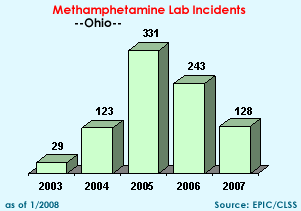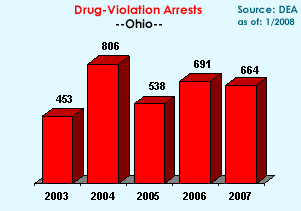|
DEA
Offices & Telephone Nos.
Cincinnati—513-684-3671
Cleveland—216-522-3705
Columbus—614-255-4200
Dayton—973-291-1988
Toledo—419-259-6490
Youngstown—330-740-7000 |
State Facts
Population: 11,464,042
State Prison Population: 44,806
Probation Population: 227,891
Violent Crime Rate
National Ranking: 28 |
2007
Federal Drug Seizures
Cocaine: 334.8 kgs.
Heroin: 11.3 kgs.
Methamphetamine: 0.7 kgs./105 du
Marijuana: 1,937.3 kgs.
Hashish: 0.0 kgs.
MDMA: 0.0 kgs/34,370 du
Meth
Lab Incidents: 128
(DEA, state, and local) |
Drug
Situation: Cocaine, heroin, and marijuana are the primary drug threats in the state of Ohio. The most violent crimes in the state are attributed to cocaine and crack cocaine distribution and abuse. Cocaine is transported from the Southwest Border to cities throughout Ohio as well as to Detroit, Michigan, and Chicago, Illinois, where it is then distributed to Ohio cities. The rising availability of high-purity, low cost heroin is creating a large user population with a greater physical risk to users, who are younger than ever before. In the northern Ohio region, South American and Mexican black tar heroin are prevalent, while in the southern Ohio region, Mexican black tar heroin is predominant. Mexican brown powder heroin also appears in both regions. Dominican criminal groups control the distribution of South American heroin, while Mexican criminal groups control the distribution of Mexican black tar heroin. At the retail-level, Dominican, Mexican, and inner-city criminal groups distribute heroin. Marijuana is the most abused drug in the state. Ohio is a source area for marijuana cultivation, as well as a distribution point, for Mexican marijuana from the Southwest Border. The rural areas of southern Ohio provide an adequate environment for marijuana outdoor cultivation. The use of hydroponics and other sophisticated indoor growing techniques produce sinsemilla with a high THC content continues to increase.
 Cocaine:
Cocaine is transported into Ohio from the Southwest Border. Detroit, Michigan, and Chicago, Illinois, also serve as transshipment points and distribution centers for cocaine shipped from the Southwest Border. Mexican criminal groups and, to a lesser extent, other ethnic criminal groups are the principal transporters and distributors of wholesale multi-kilogram quantities in Ohio. Average cocaine purity is 70% and crack cocaine purity is 66%. Cocaine:
Cocaine is transported into Ohio from the Southwest Border. Detroit, Michigan, and Chicago, Illinois, also serve as transshipment points and distribution centers for cocaine shipped from the Southwest Border. Mexican criminal groups and, to a lesser extent, other ethnic criminal groups are the principal transporters and distributors of wholesale multi-kilogram quantities in Ohio. Average cocaine purity is 70% and crack cocaine purity is 66%.
 Heroin:
South American and Mexican black tar heroin are prevalent in the northern Ohio region and Mexican black tar heroin is predominant in the southern Ohio region. Heroin is transported from the Southwest Border to cities throughout Ohio as well as to Detroit, Michigan, and Chicago, Illinois, where it is then distributed to Ohio cities. Dominican criminal groups control the distribution of South American heroin, while Mexican criminal groups control the distribution of Mexican black tar heroin. At the retail-level, Dominican, Mexican, and inner-city criminal groups distribute heroin. Heroin wholesale traffickers utilize major Ohio cities, such as Cleveland, Cincinnati, Columbus, and Toledo as distribution centers for smaller cities in Ohio. Heroin:
South American and Mexican black tar heroin are prevalent in the northern Ohio region and Mexican black tar heroin is predominant in the southern Ohio region. Heroin is transported from the Southwest Border to cities throughout Ohio as well as to Detroit, Michigan, and Chicago, Illinois, where it is then distributed to Ohio cities. Dominican criminal groups control the distribution of South American heroin, while Mexican criminal groups control the distribution of Mexican black tar heroin. At the retail-level, Dominican, Mexican, and inner-city criminal groups distribute heroin. Heroin wholesale traffickers utilize major Ohio cities, such as Cleveland, Cincinnati, Columbus, and Toledo as distribution centers for smaller cities in Ohio.
  Methamphetamine:
Methamphetamine manufacturing has stabilized due to recent pseudoephedrine sales restrictions at Ohio pharmacies. Small “Mom and Pop” and “Tweaker” operators continue to manufacture methamphetamine in small one to two ounce quantities for personal use and for distribution at the local level. Primary suppliers of methamphetamine are Mexican drug trafficking organizations. Average purity of methamphetamine is 70%. Methamphetamine:
Methamphetamine manufacturing has stabilized due to recent pseudoephedrine sales restrictions at Ohio pharmacies. Small “Mom and Pop” and “Tweaker” operators continue to manufacture methamphetamine in small one to two ounce quantities for personal use and for distribution at the local level. Primary suppliers of methamphetamine are Mexican drug trafficking organizations. Average purity of methamphetamine is 70%.
 MDMA and other Club Drugs The Northern Border in New York serves as a transshipment point for predatory and club drugs, such as MDMA, GHB, Ketamine, and LSD. Laboratories in the Netherlands and Belgium are transported to Ohio through the distribution centers located in Miami, New York City, Philadelphia and Washington, D.C. Club drugs are popular among young adults and juveniles, particularly in the urban areas of the state. Most MDMA traffickers are loosely-knit independent entrepreneurs. Retail dealers are typically suburban teenagers that are high school or college students. MDMA and other Club Drugs The Northern Border in New York serves as a transshipment point for predatory and club drugs, such as MDMA, GHB, Ketamine, and LSD. Laboratories in the Netherlands and Belgium are transported to Ohio through the distribution centers located in Miami, New York City, Philadelphia and Washington, D.C. Club drugs are popular among young adults and juveniles, particularly in the urban areas of the state. Most MDMA traffickers are loosely-knit independent entrepreneurs. Retail dealers are typically suburban teenagers that are high school or college students.
 Marijuana: The rural areas of Ohio provide an ample environment for outdoor cultivation, predominantly in southern Ohio. The use of hydroponics and other sophisticated indoor growing techniques produce sinsemilla with a high THC content continues to increase. Marijuana transported into Ohio from the Southwest Border is primarily distributed by Mexican and inner-city criminal groups. Marijuana: The rural areas of Ohio provide an ample environment for outdoor cultivation, predominantly in southern Ohio. The use of hydroponics and other sophisticated indoor growing techniques produce sinsemilla with a high THC content continues to increase. Marijuana transported into Ohio from the Southwest Border is primarily distributed by Mexican and inner-city criminal groups.
 Other
Drugs: The diversion and abuse of OxyContin represent a significant drug threat in Ohio. OxyContin, a powerful pain reliever whose effects are the same as other opiate derivatives, is obtained legally through prescriptions as well as illegally on the street. Formerly seen as a drug of abuse primarily among the Caucasian population, law enforcement officials in Ohio report increasing abuse among African Americans. According to the Ohio Department of Alcohol and Drug Addiction Services, youth abusers of OxyContin have begun abusing heroin since they can no longer obtain or afford OxyContin. Continued incidents of overdoses and drug-related deaths were reported throughout the state during 2006. Also, a direct connection between abuse of this drug and drug-related robberies has been established. Other
Drugs: The diversion and abuse of OxyContin represent a significant drug threat in Ohio. OxyContin, a powerful pain reliever whose effects are the same as other opiate derivatives, is obtained legally through prescriptions as well as illegally on the street. Formerly seen as a drug of abuse primarily among the Caucasian population, law enforcement officials in Ohio report increasing abuse among African Americans. According to the Ohio Department of Alcohol and Drug Addiction Services, youth abusers of OxyContin have begun abusing heroin since they can no longer obtain or afford OxyContin. Continued incidents of overdoses and drug-related deaths were reported throughout the state during 2006. Also, a direct connection between abuse of this drug and drug-related robberies has been established.
Pharmaceutical Diversion: The abuse and diversion of oxycodone, hydrocodone, benzodiazepines (Valium and Xanax) and the generic equivalent, alprazolam, are increasing throughout the state. Primary methods of diversion are illegal sales and distribution by health care professionals and workers, “doctor shopping, and robberies. According to the Ohio Department of Alcohol and Drug Addiction Services, youth abusers of OxyContin will begin abusing heroin when they can no longer obtain or afford OxyContin. Abuse of Oxycodone and drug-related robberies Also, a direct connection between abuse of this drug and drug-related robberies has been established.
 DEA
Mobile Enforcement Teams: This cooperative program with state and local law enforcement counterparts was conceived in 1995 in response to the overwhelming problem of drug-related violent crime in towns and cities across the nation. Since the inception of the MET Program, there have been seven MET deployments in the State of Ohio; Toledo, Cleveland, East Cleveland, Jefferson County, Lincoln Heights, Warren, Youngstown and Steubenville. DEA
Mobile Enforcement Teams: This cooperative program with state and local law enforcement counterparts was conceived in 1995 in response to the overwhelming problem of drug-related violent crime in towns and cities across the nation. Since the inception of the MET Program, there have been seven MET deployments in the State of Ohio; Toledo, Cleveland, East Cleveland, Jefferson County, Lincoln Heights, Warren, Youngstown and Steubenville.
DEA
Regional Enforcement Teams:
This program was designed to augment existing DEA division resources
by targeting drug organizations operating in the United States where
there is a lack of sufficient local drug law enforcement. This program
was conceived in 1999 in response to the threat posed by drug trafficking
organizations that have established networks of cells to conduct drug
trafficking operations in smaller, non-traditional trafficking locations
in the United States. As of January 31, 2005, there have been 27 deployments nationwide, and one deployment in the U.S. Virgin Islands, resulting in 671 arrests. There have been no RET deployments in the State of Ohio.
Special
Topics: HIDTA: During June 1999, ONDCP designated areas within northern Ohio as the Ohio High Intensity Drug Trafficking Area (Ohio HIDTA). The HIDTA region was expanded during 2004 to include central and southern Ohio counties. The Ohio HIDTA is comprised of the Ohio counties; Cuyahoga, Lucas, Mahoning, Stark, Summit, Fairfield, Franklin, Greene, Hamilton, Warren and Montgomery. Currently the following agencies are assigned responsibilities in the Ohio HIDTA program: U.S. Drug Enforcement Administration, Federal Bureau of Investigation, Internal Revenue Service, Immigration and Customs Enforcement, U.S. Coast Guard, Ohio Bureau of Criminal Identification and Investigations, and other local police departments and law enforcement agencies.
More information
about the Detroit Division Office.
Sources
Factsheet
last updated: 3/2008
Click
here for last year's factsheet >>
|

